|
Port Mold Analysis
Before reviewing any flow and swirl
data on our Cleveland heads, we took port
molds of the intake and exhaust runners on all three heads
(2V, 4V, and Edelbrock). You may have see FordMuscle perform
this process in other articles. Once cured and removed, the
silicone molds are great supportive visuals for the corresponding
flow data found on Page
4 of this article. Here's the process in case you ever
want to try this at home. It's a good technique if you plan
on home porting any cylinder head.
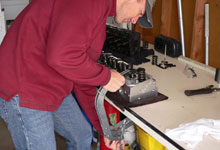
 We popped an intake and exhaust valve from each head.
We popped an intake and exhaust valve from each head.
|
|

 Mixed up the silicone RTV and catalyst.
Mixed up the silicone RTV and catalyst. |
| |
|
|
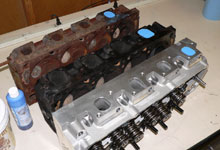
 Waited 6 hours for the exhaust port molds to cure.
Waited 6 hours for the exhaust port molds to cure.
|
|
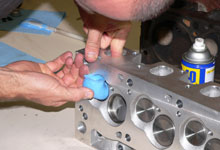
 Carefully coaxed them out of each head then repeated the
process for
Carefully coaxed them out of each head then repeated the
process for
the intake side. |
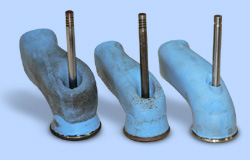 Intake
Runners Intake
Runners
Intake runner design, shape, and
contour is almost completely responsible for a cylinder head's
intake flow velocity and ability to promote, prevent, or control
the mixture's motion or swirl effect. The following visual
comparison of our Cleveland intake runner molds offers information
not seen by simply looking at an intake port's footprint or
peering into the dark corridor we call the intake runner.
Pictured from left to right is the factory 351C 4V intake
runner, the factory 351C 2V intake runner, and Edelbrock's
Performer RPM 351C intake runner. The average joe may not
notice the subtleties between these three blue globs, but
hardcore enthusiasts, cylinder head porters, and design engineers
can quickly point to the improvements of modern head design
over early 1970's designs. Let's take a closer look:
|
Factory
Iron 351 Cleveland 2V Head Intake Port
|
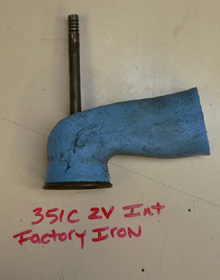
Profile View
The factory 2V intake runner shows a hard turn towards
the valve forming an undesirable and abrupt "L"
shape. Also, note the bullnose that essentially forces
the intake charge into the runner wall right above the
valve.
|
|
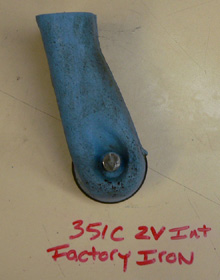
Top View
From the top, the 2V intake runner has a fairly consistent
cross-section
which by itself is conducive to maintaining the velocity.
However, based on the previous photo and the obtrusive
valve guide boss (shown as an impression around the valve
stem here) this runner can be improved with porting and
machine work.
|
| |
|
|
|
Factory
Iron 351 Cleveland 4V Head Intake Port
|
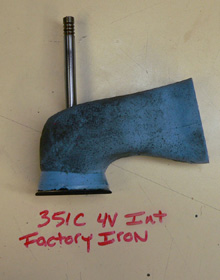
Profile View
The profile of the notorious 4V intake runner is like
a bloated version
of the 2V runner. The mold shows the same bullnosed "L"
shape, unlike the 2V however, the 4V's port entry has
a distinct "hogged-out" floor which creates
an unwanted high static pressure area. This area is sometimes
filled-in with epoxy or special port plates to give the
intake charge a straighter shot at the valve, these modifications
will help maintain flow velocity. (See sidebar)
|
|
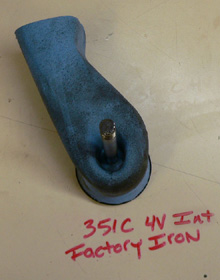
Top View
From the top, the 4V runner contradicts modern aftermarket
runner designs with a "quick pinch" followed
by a large jog outward as the runner approaches the valve.
In theory, the sudden change in cross-section from small
to large can only serve to slow flow velocity. While the
"quick pinch" may act in a venturi effect to
increase velocity, the effect is happening too soon slowing
the charge well before the intake valve. However, the
shear size of the port alone is what always contributes
to high flow numbers for the factory 4V head. As with
the 2V head, the obtrusive valve guide boss is also apparent. |
| |
|
|
|
Edelbrock
351 Cleveland Head Intake Port
|
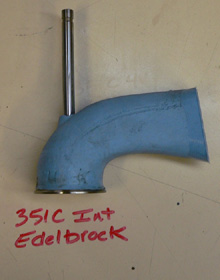
Profile View
The profile of the Edelbrock intake runner is a clear
testament to modern computer-aided cylinder head design.
Note the contoured shape that forms a "J" rather
than an "L" like the factory iron head. There
are no sharp turns or obstructions. The cross- section
is a bit larger than the factory 2V but much smaller than
the 4V. The cross-section gradually decreases in size
as the charge approaches the valve, this helps increase
flow velocity. Gone is the bullnosed shape that sends
the mixture crashing into the runner wall. |
|
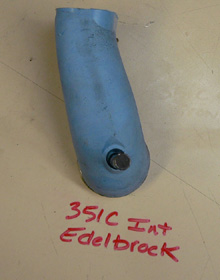
Top View
There's nothing too exciting about the Edelbrock intake
runner when viewed from above, and that's a good thing!
The lack of character indicates an unobstructed straight
shot at the intake valve. As with most modern cylinder
head designs, the valve guide boss does not protrude into
the runner. Designs like these, by their nature, can create
a controlled swirl effect. We'll discuss swirl on Page
3 of this article. |
Exhaust Runners
Like intake runners, an exhaust runner's design, shape, and
contour influence flow potential. While you may have been
running Cleveland heads all your life, you probably have not
seen the exhaust ports of a 2V and 4V displayed as we've done
here. Let's take a look.
 (The
Twist on Swirl, Flow and Swirl Testing) (The
Twist on Swirl, Flow and Swirl Testing)
|

